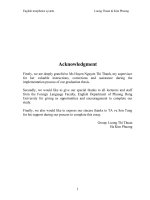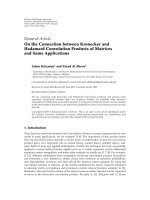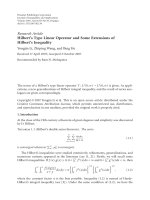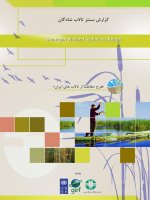English morpheme system and some applications of learning morpheme in establishing words
Bạn đang xem bản rút gọn của tài liệu. Xem và tải ngay bản đầy đủ của tài liệu tại đây (207.5 KB, 22 trang )
English morpheme system Luong Thuan & Kim Phuong
Acknowledgment
Firstly, we are deeply grateful to Ms Huyen Nguyen Thi Thanh, my supervisor
for her valuable instructions, corrections and assistance during the
implementation process of our graduation thesis.
Secondly, we would like to give our special thanks to all lecturers and staff
from the Foreign Language Faculty, English Department of Phuong Dong
University for giving us opportunities and encouragement to complete our
study.
Finally, we also would like to express our sincere thanks to TA vu Son Tung
for his support during our process to complete this essay.
Group: Luong Thi Thuan
Ha Kim Phuong
1
English morpheme system Luong Thuan & Kim Phuong
OUTLINE
Part I: Introduction.
1. Rationale (reasons of the study).................................................................3
2. Aims of the study.......................................................................................3
3. Scope of the study......................................................................................3
4. Methods of the study..................................................................................4
Part II: Development.
Chapter 1: Theoretical background.
I. An overview of English morpheme
I.1. Definition of Morpheme .................................................................5
I.2. Type of morpheme...........................................................................6
II. An overview of Vietnamese morpheme
II.1. Definition of Vietnamese morpheme...............................................9
II.2. Derivational morphology: word formation......................................9
Chapter 2: Comparison with Vietnamese morphology.
1. The similarities....................................................................................11
2. The difference.....................................................................................13
3. Some suggestion.................................................................................15
Part III: Conclusion.....................................................................18
Exercises........................................................................................19
References.....................................................................................23
2
English morpheme system Luong Thuan & Kim Phuong
Part I: Introduction
1. The rationale
“Language is the most important social communication among countries and
people in the world”, said V.I Lenin. As the world changes and develops, the
global integration becomes the trend in all over the world. All countries,
including Viet Nam have been cooperated with each other in many aspects of
society in order to enhance development of economy. It designated
international communication as an important part of all sectors. English is
considered as the international language which is widely used all over the
world. However, each language as well as English has its own typical features
which make difficulties for learners. To learn English well, first of all, we
should understand deeply about its morpheme system.
Living in a community, human beings need a tool to communicate with each
other, and to carry on human and social affairs. They, therefore, arbitrarily
named the things and occurrences around making use of vocal sounds for the
purpose of communication. After that they showed the vocal sounds and sets of
vocal sounds in written signals.
Because of these reasons, we decided to choose the topic “English morpheme
system and some applications of learning morpheme in establishing words”.
2. Aims of the study
We hope that our study is useful for English learners, for those who want to
consolidate their knowledge about morpheme. Furthermore, it can help people
significantly improve their vocabulary to apply in translation and finally, they
can also guess meanings new words without using dictionary.
3. Scope of the study.
The elimination of the essay is from 15-20 pages, so we can only deal with
• Definition, types of English morpheme.
• Definition, types of Vietnamese morpheme.
• Some suggestions in forming words.
3
English morpheme system Luong Thuan & Kim Phuong
4. The methods of the study.
To complete this study, we used some following methods:
+ Library research: we collected the data from curriculums, internet, and some
valuable books of foreign and domestic scholars. We think these are valuable
sources to effectively support for our study.
+ Comparison: we gave out the similarities and differences between English
morpheme and Vietnamese morpheme.
5. Design of the study.
Our essay is divided into five main parts:
Part I: Introduction
Part II: Development
This is divided into 2 chapters:
Chapter 1: Some theoretical background knowledge.
Chapter 2: Comparison with Vietnamese morphology
Part III: Conclusion
Part IV: References
Part V: Exercises
4
English morpheme system Luong Thuan & Kim Phuong
Part II. Development
Chapter 1: Theoretical background
I. An overview of English morpheme
I.1. Definition
A morpheme is the smallest isolable unit in the linguistic structure which caries
an independent meaning for example a noun or a verb stem as well as a suffix or
prefix, and the meaning can be specific such as John (proper name), general such
as a house, or purely grammatical such as pluralize, verbalize, etc.
The first part of the definition is the sequence of words smallest isolable unit,
which means that these elements are the shortest stretches of sound which can be
replaced by another such segment, and which always have some element of
meaning attached to them, however broad or general this meaning might be.
The final requirement, for example, meaning associated with the segment, is
necessary to eliminate the possibility of having two morphemes, such as cut
and cot in which it might be said that the meaning difference between the two
units was carried by the single phonemic distinction /ʌ/ and /ɔ/, which is of
course true on the phonemic level of analysis, but it is probable also true that
the meaning distinction is carried by only a single distinctive feature on the
distinctive feature level of analysis.
These are some examples of morpheme:
• One morpheme boy (one syllable)
desire, lady, water (two syllables)
crocodile (three syllables)
salamander (four syllables
• Two morpheme boy + ish
desire + able
• Three morpheme boy + ish + ness
desire + able + ity
• Four morpheme gentle+man+li + ness
un + desire + able + ity
• More than four un + gentle + man + li + ness
anti + dis + establish + ment + ari + an +
ism
5
English morpheme system Luong Thuan & Kim Phuong
I.2. Types of English morpheme
I.2.1. Root morpheme
A root is a morpheme that cannot be analyzed into smaller parts. It is also
called the lexical morpheme or simply the root.
Example: book, system, school, etc.
6
Morpheme
Root morpheme
Affixational
morpheme
free
morpheme
Bound
morpheme
The
inflectional
morpheme
The
derivational
morpheme
Prefix
Suffix
English morpheme system Luong Thuan & Kim Phuong
Free Root Morpheme: run, bottle, phone, etc.
Bound Root Morpheme: receive, remit, uncouth,
nonchalant, etc
1.2.1.1. Free morphemes
• Free morphemes are those that can stand alone as words.
E.g.: girl system
Desire hope
Act phone
Happy love
1.2.1.2. Bound morphemes
Bound morphemes (affixes) must be attached to the word. They are prefixes,
infixes, suffixes, such as {happy} as in unhappy, happily, happiness) or they
may be grammatical (such as called, closing, and faster).
1.2.2. Affixational morpheme
The affixational morpheme is further divided into inflectional morpheme and
derivational morpheme.
1.2.2.1. The inflectional morpheme
Inflectional morphemes have grammatical meaning or function in the sentence,
they never change part of speech. It also called grammatical morpheme.
Words can have an internal structure much like the syntax of phrases.
Morphemes such as the, -s, and re- near the grammatical end of the continuum
are called grammatical morphemes.
Note that grammatical morphemes include forms that we can consider to be
words like the, a, and, and of and others that make up parts of words like –s
and -ed.
7
English morpheme system Luong Thuan & Kim Phuong
E.g. pencils walked
1.2.2.2. The derivational morpheme
Root morpheme combines with Derivational Morpheme forming a new word
with a new meaning (usually change grammatical class)
N + Derivational Morpheme --> Adj
• E.g.: mountain + ous,
Verb + Derivational Morpheme --> Noun
• E.g.: clear + ance
Adj. + Derivational Morpheme --> Adverb
• E.g.: Exact + ly
The Derivational morpheme consists of affix, which includes prefix and suffix.
Affix is a morpheme that comes at the beginning (prefix) or the ending (suffix)
of a base morpheme. An affix usually is a morpheme that cannot stand alone.
Examples: -ful, -ly, -ity, -ness.
A few exceptions are able, like, and less.
a. Prefix is an affix that comes before a base morpheme.
E.g.: The -in in inspect.
b. Suffix is an affix that comes after a base morpheme.
E.g.: The -s in cats.
II. Vietnamese morpheme
II.1. Definition of Vietnamese morpheme
8









